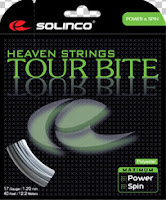In general, the Cyclone has been considered a great half-priced alternative to the (overpriced?) Babolat RPM Blast. You probably came across this post since you appreciate its spin to price ratio, while being pretty well rounded otherwise as well (as opposed to the spin chart topping Ultra Cable, for example).
Ironically, despite making a gear shaped string, that's been on the market for years, while most players have been looking for spin strings... Volkl is still not saying anything in regards to spin on the packaging!
The Cyclone is still available in black, yellow, and orange. Serious players would probably choose by playing characteristics, but then there's also aesthetics, and price.
Between the different colors, I found that prices can differ up to about 30%. So for example, should one just buy the cheapest one?

Here's a quick comparison of playing characteristics of the available colors - but first, the setup:
Racquet: Wilson Pro Staff RF97 Autograph
Tension: 23/22 kgs (~51 / 49 lbs) via a Wise Tension Head, constant pull
Gauge: 1.25mm / 17, which has always been my top choice.
Black Cyclone - Surprisingly the softest of the bunch. Playing-feel-wise, it's probably the most similar to the RPM Blast, even though the Blast is much stiffer. Does not snap back as loudly as the other 2. Seemed like the most powerful too.
Yellow Cyclone - To me, the most generic feeling - I remember nothing really stood out to me. When I tested, it seemed to sit right between the comfort and power of the black and the spin of the orange Cyclone. If you want an allrounder, this might be worth a try.
Orange Cyclone - Most audible snapback, suggesting it's the most spin friendly, and feels like it to. Still appears somewhat plasticky to me, maybe the least powerful of the 3. Combined, that makes it the most predictable, which is why I stuck with orange for a while (and came back to it in 2018 after playing the Hyper-G for a couple of seasons).

Here's a quick comparison of playing characteristics of the available colors - but first, the setup:
Racquet: Wilson Pro Staff RF97 Autograph
Tension: 23/22 kgs (~51 / 49 lbs) via a Wise Tension Head, constant pull
Gauge: 1.25mm / 17, which has always been my top choice.
Black Cyclone - Surprisingly the softest of the bunch. Playing-feel-wise, it's probably the most similar to the RPM Blast, even though the Blast is much stiffer. Does not snap back as loudly as the other 2. Seemed like the most powerful too.
Yellow Cyclone - To me, the most generic feeling - I remember nothing really stood out to me. When I tested, it seemed to sit right between the comfort and power of the black and the spin of the orange Cyclone. If you want an allrounder, this might be worth a try.
Orange Cyclone - Most audible snapback, suggesting it's the most spin friendly, and feels like it to. Still appears somewhat plasticky to me, maybe the least powerful of the 3. Combined, that makes it the most predictable, which is why I stuck with orange for a while (and came back to it in 2018 after playing the Hyper-G for a couple of seasons).
Price-wise, around $100 / €100 for a 200m reel seems fair. I've seen some colors offered for as low as €90. In the US, the current market price seems to be ~$120. That's still only half of what the RPM costs over there, however starts to creep up on other popular choices such as the Solinco Tour Bite
or Hyper-G (~ $160). So if I was Völkl I'd probably make sure to keep that gap...
Compared to some of the competition, I'd say less spin but more power and comfort than the Tour Bite, a bit more spin but less pop and worse long-time playability compared to the Hyper-G, and softer playing than the black Moto and certainly the Black Widow.
Finally, quick note that a review and comparison of the V-Torque, V-Torque Tour, and V-Star is next on the list, probably happening sometime later this summer (2018). Also, I had already tried the Cyclone Tour a few times, and found it softer, less spinny, but mostly sucking a bunch of power on impact!
More regarding other stings in this comparison.
If you'd like to dig into the Cyclone topic some more, you can take a look at my 50+ Cyclone stringjobs with ratings and commentary...





